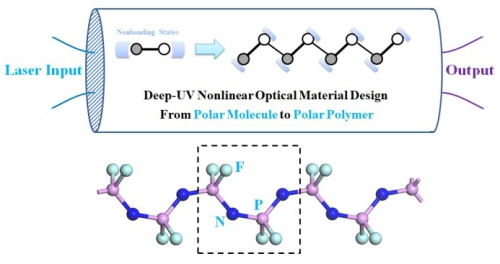Deep-ultraviolet (DUV) nonlinear optical (NLO) materials play an important role in the practical application of all-solid-state laser technology. However, DUV NLO materials are rare due to stringent performance specifications. KBe2BO3F2 (KBBF) is the only practical DUV NLO material to date. It has very important application value in some advanced technologies, such as developing angular resolved photoelectron spectroscopy operating at 177.3 nm (the critical wavelength for the surface state measurements of high-temperature superconductors, topological insulators and 2D materials, etc.).
According to the anionic group theory, DUV NLO materials are rare because it is difficult to simultaneously satisfy sufficiently large optical bandgap and birefringence for most anionic groups. Therefore, most NLO structures either have small bandgap, such as β-BaB2O4, which cannot effectively pass through a DUV 177.3 nm light, or have small birefringence, such as LiB3O5, which cannot achieve the phase-matching condition for the double-frequency process. Therefore, in order to obtain excellent DUV NLO materials, it is expected to obtain possible crystal structures with large bandgaps and birefringence while exhibiting sufficient NLO effects.

Figure 1. Development of NLO motifs and design strategy from polar molecule to polar polymer.
Recently, Prof. LIN Zheshuai from Technical Institute of Physics and Chemistry, Chinese Academy of Sciences, collaborated with Dr. KANG Lei and Prof. HUANG Bing from the Beijing Computational Science Research Center to integrate 1D polar chain groups into quasi-1D polar polymer. In the long-chain structure, the structural anisotropy (and the birefringence) of the NLO system is effectively expanded, and the non-bonding states are greatly saturated (thus the bandgap is enlarged). Under the guidance of this design strategy, they systematically focused on the phosphazene polymer system with a polar chain arrangement and successfully found an experimental inorganic polymer structure in the crystal database, i.e., poly(difluorophosphazene) with the chemical formula of (PNF2)n, whose structure is in line with the theoretical concept of DUV NLO polymer materials in this work. Moreover, theoretical calculations of the system show that the poly(difluorophosphazene) exhibits a large bandgap (7.8~8.7 eV), a large second harmonic generation effect (1.2~1.9 times of KBBF), and a large birefringence (0.10~0.16 at 400 nm) and a shorter DUV phase-matching output wavelength (142~158 nm). Accordingly, it is predicted to be slightly better than KBBF in the DUV NLO capability. It is worth noting that poly(difluorophosphazene) is the first non-oxide material and polymer material with DUV NLO properties. As a forward-looking theoretical work, it provides a new research idea and design strategy for the study of DUV NLO materials. Related results have been published on Angewandte Chemie International Edition (Angew. Chem. Int. Ed. 10.1002/anie.201905025).
https://onlinelibrary.wiley.com/doi/10.1002/anie.201905025
Email: zslin@mail.ipc.ac.cn
NEWS